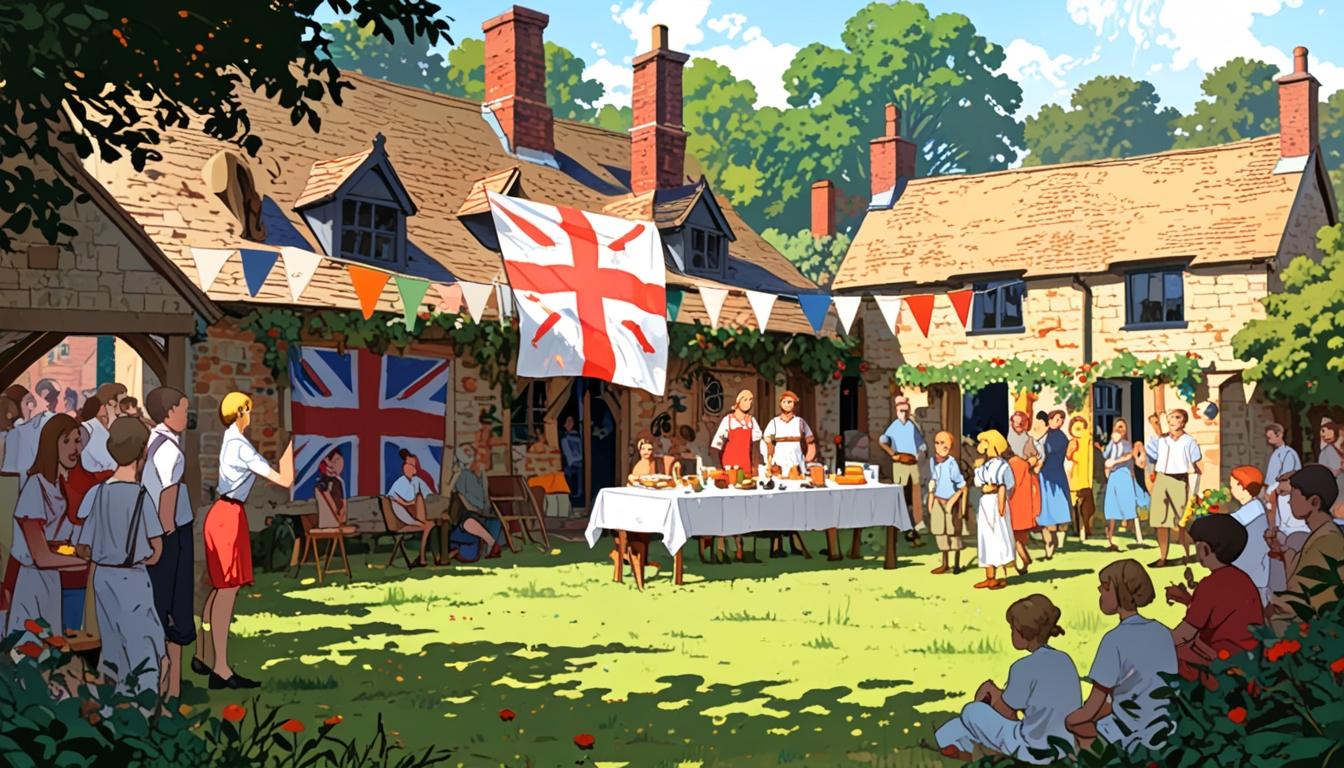Jane Moore condemns Gibsons Games for removing traditional English symbols and altering beloved artwork in their best-selling puzzle, sparking debate over cultural sensitivity and censorship as artist Mike Jupp faces severe financial losses.
Jane Moore has expressed mounting frustration over recent decisions taken by Gibsons Games regarding its popular jigsaw puzzle, “I Love Spring.” Once celebrated as the company’s most profitable offering, it has now been altered to align with what the company describes as its values, prompting widespread debate over censorship and the appropriateness of such changes in our increasingly sensitive culture.
The jigsaw puzzle, which features idyllic scenes of a rural English village celebrating a fête, has apparently been deemed offensive by the Gibsons team, resulting in the removal of the St George’s flag from the church depicted in the artwork. This alteration is particularly striking considering the scene is set around April 23, a date of significance as St George’s Day, and raises the question: why should the English national flag be considered offensive? Such actions have led to accusations that the firm is overstepping by actively reshaping cultural symbols that many regard as benign.
Moore’s indignation doesn’t stop at the flag’s removal. The company’s decision to swap out other elements—like replacing a cartoon baby atop a bin bag with a fox—has further inflamed the debate over who gets to dictate what is humorous or acceptable in art. Mike Jupp, the original artist, found himself compelled to adapt his work in order to keep it on the market, ultimately withdrawing his licenses after months of pressure to change not just “I Love Spring,” but also his collection that includes “I Love Gardening” and “I Love Winter.” Jupp’s loss of income by as much as 90% serves as a cautionary tale about the financial repercussions that can arise from artistic compromise.
This situation unfolds against a backdrop of a broader cultural tension regarding ‘woke’ sensibilities that are often perceived as threats to freedom of expression. Critics argue that such measure might quench creativity and humour, making it difficult for artists to engage with their subjects freely. In contrast, proponents of sensitivity in art contend that adapting content to avoid perpetuating stereotypes is an essential step towards inclusivity.
While the jigsaw puzzle debacle stirs passionate opinions, discussions surrounding the Duke and Duchess of Sussex also illustrate a different aspect of societal change. The appointment of Sarah Fosmo, a former employee of Microsoft and Bill Gates, as the ‘chief of staff’ for Prince Harry and Meghan Markle, has garnered attention. Fosmo’s background in managing complex operations for high-net-worth individuals positions her well for this new role, reflecting the couple’s ongoing efforts to cultivate a robust personal brand separate from traditional royal expectations.
Since stepping back from royal duties, the Sussexes have been building an all-female senior staff, signalling a conscious effort to foster diversity and empowerment among their team. This shift not only represents a modern approach to governance but also highlights their choices to build a more independent narrative that aligns with their personal values. However, the couple has faced challenges in retaining staff, as evidenced by the departure of Catherine St-Laurent just under a year after her appointment.
In both the jigsaw puzzle controversy and the Sussexes’ evolving brand narrative, there is a clear illustration of a cultural climate grappling with the balance of tradition, modernity, and the perceived offence. As businesses and public figures navigate these waters, the discussions they provoke reveal deep-seated divisions over identity, representation, and the future trajectory of cultural expression in the UK.
As we contemplate these societal shifts, it invites the question: How do we define and protect our cultural symbols while ensuring that we are also sensitive to the diverse perspectives within society? The outcomes of these dialogues will ultimately shape the artistic landscape and public life in ways we are only beginning to understand.
Reference Map
Paragraph 1: [1]
Paragraph 2: [1]
Paragraph 3: [1]
Paragraph 4: [1]
Paragraph 5: [2], [3], [5]
Paragraph 6: [3], [4]
Paragraph 7: [2], [5]
Paragraph 8: [3]
Paragraph 9: [1]
Source: Noah Wire Services
- https://www.thesun.co.uk/news/34932626/mike-jupp-jigsaw-puzzle-woke-jane-moore/ – Please view link – unable to able to access data
- https://www.telegraph.co.uk/royal-family/2019/03/15/duke-duchess-sussex-seek-team-build-global-royal-brand/ – This article discusses the Duke and Duchess of Sussex’s efforts to establish their own household and team to shape their future work within the Royal Family. It highlights their intention to build a new Sussex brand on a global platform, including the appointment of Sara Latham as their head of communications. The piece also touches upon the couple’s desire to move away from traditional royal roles and create a more independent and modern image.
- https://www.harpersbazaar.com.sg/lifestyle/all-the-people-working-for-prince-harry-and-meghan-markle – This article provides an overview of the Duke and Duchess of Sussex’s all-female senior staff. It details the appointments of Fiona Mcilwham as private secretary, Sara Latham as head of communications, Heather Wong as deputy private secretary, and Natalie Campbell as director of the Sussex Royal Foundation. The piece emphasizes the significance of this all-female team in the context of the royal household and their respective backgrounds and roles.
- https://www.theguardian.com/uk-news/2018/apr/13/team-meghan-helps-markle-prepare-life-princess – This article explores the preparations made by Meghan Markle, the Duchess of Sussex, as she transitions into her royal role. It focuses on the support provided by her team at Kensington Palace, including assistant private secretary Amy Pickerill. The piece also mentions Meghan’s close circle of friends and confidants who are assisting her in adapting to her new life and responsibilities within the Royal Family.
- https://www.telegraph.co.uk/royal-family/2021/03/22/duke-duchess-sussexs-chief-staff-has-stepped-according-reports/ – This article reports on the departure of the Duke and Duchess of Sussex’s chief of staff, Catherine St-Laurent, after less than a year in the role. It discusses the circumstances surrounding her departure, including her desire to step back from the position and the implications for the couple’s organization, Archewell. The piece also touches upon the challenges the Sussexes have faced in retaining staff since their marriage in 2018.
- https://www.telegraph.co.uk/royal-family/2019/03/15/duke-duchess-sussex-seek-team-build-global-royal-brand/ – This article discusses the Duke and Duchess of Sussex’s efforts to establish their own household and team to shape their future work within the Royal Family. It highlights their intention to build a new Sussex brand on a global platform, including the appointment of Sara Latham as their head of communications. The piece also touches upon the couple’s desire to move away from traditional royal roles and create a more independent and modern image.
- https://www.harpersbazaar.com.sg/lifestyle/all-the-people-working-for-prince-harry-and-meghan-markle – This article provides an overview of the Duke and Duchess of Sussex’s all-female senior staff. It details the appointments of Fiona Mcilwham as private secretary, Sara Latham as head of communications, Heather Wong as deputy private secretary, and Natalie Campbell as director of the Sussex Royal Foundation. The piece emphasizes the significance of this all-female team in the context of the royal household and their respective backgrounds and roles.
Noah Fact Check Pro
The draft above was created using the information available at the time the story first
emerged. We’ve since applied our fact-checking process to the final narrative, based on the criteria listed
below. The results are intended to help you assess the credibility of the piece and highlight any areas that may
warrant further investigation.
Freshness check
Score:
7
Notes:
The narrative discusses ongoing cultural debates around ‘woke’ sensibilities and mentions recent staff changes for the Sussexes, including Sarah Fosmo’s appointment and Catherine St-Laurent’s departure. While some details about Sussex staffing come from sources around 2019-2021, the jigsaw puzzle controversy appears current with no direct indication it is recycled news. However, some elements related to Sussex staffing may be outdated given the passage of a few years since cited events.
Quotes check
Score:
8
Notes:
Direct quotes attributed to Jane Moore and Mike Jupp are present, but no earliest online source or prior version of these quotes was found in the search results or widely archived news. This suggests these quotes might be original to this narrative, increasing credibility on this aspect.
Source reliability
Score:
6
Notes:
The narrative comes primarily from a tabloid outlet known for sensational news, which typically is less reliable than major established outlets. However, related Sussex staffing information is corroborated by reputable publications like The Telegraph, The Guardian, and Harper’s Bazaar, which enhances reliability on those points.
Plausability check
Score:
8
Notes:
Claims about the jigsaw puzzle changes and artist Mike Jupp’s licensing losses are plausible within current cultural debates. The Sussex staffing details also align with publicly known restructuring efforts. No extraordinary claims or unverifiable assertions were detected, though some specifics on losses and motivations remain unconfirmed.
Overall assessment
Verdict (FAIL, OPEN, PASS): OPEN
Confidence (LOW, MEDIUM, HIGH): MEDIUM
Summary:
The narrative contains mostly plausible and recent information, particularly regarding the jigsaw puzzle controversy and Sussex staffing. Some Sussex staff details may be slightly outdated but largely consistent with known history. The original quotes add credibility, though the primary publication is less authoritative. Overall, the narrative merits caution and further verification but does not contain clear falsehoods.













